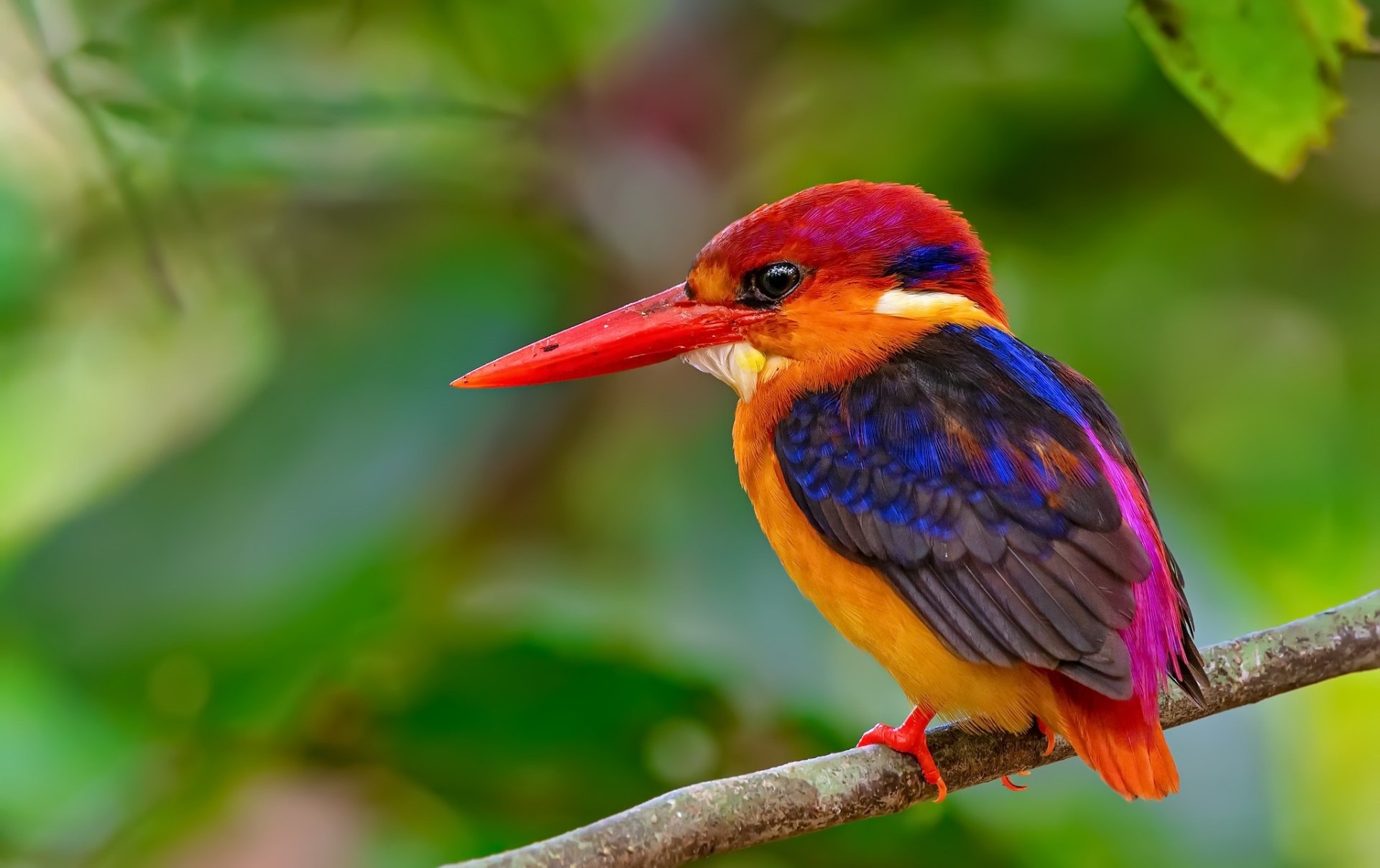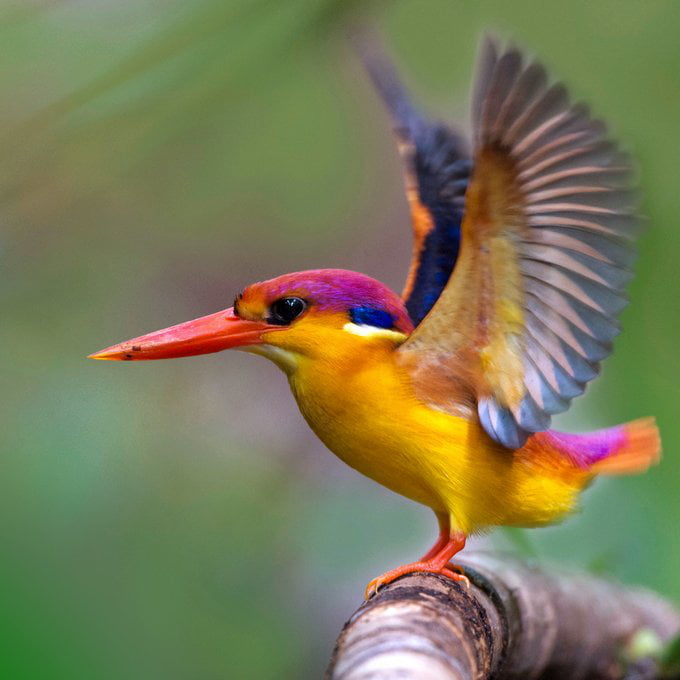
The black-backed dwarf kingfisher (Ceyx erithaca), also known as the three-toed kingfisher, is a pocket-sized bird in the family Alcedinidae. It was formerly considered as conspecific with the rufous-backed dwarf kingfisher and together the species complex was known by the English name “oriental dwarf kingfisher”.
This tropical kingfisher is a partial migrant that is endemic to parts of the Indian Subcontinent and Mainland Southeast Asia. It resides in lowland forests, typically near streams or ponds, where it feeds upon insects, spiders, worms, crabs, fish, frogs, and lizards. It is easily distinguishable from other birds in its range due to its red bill, yellow-orange underparts, lilac-rufous upperparts, and blue-black back.
The black-backed dwarf kingfisher is one of the smallest known kingfisher species. It is only slightly larger than a medium-sized hummingbird and measures 4.9–5.5 inches in length (including bill and tail). Females typically weigh 14-16g and males 14-21.5g, making the males slightly larger. The two sexes are otherwise alike and sexual dimorphism is not present. Both males and females have a black spot on the forehead; blue and white patches on the side of the neck; a lilac-rufous crown, rump, and tail; a dark blue back and wings; a white chin and throat; pale yellow-orange underparts; a dark brown iris; and red legs, feet, and bill. Juveniles are duller and have less lilac coloring; a white chin, throat and belly; yellow-orange bill with pale tip; and blue scapulars and wing-coverts. This species of kingfisher has three toes, explaining why it is sometimes called the three-toed kingfisher, however, there are other kingfishers which also have three toes. The toe-count in these kingfisher species does not appear to be adaptive. The vocalization is a high pitched, shrill “tsriet-tsriet” or soft “tjie-tjie-tjie” in flight.

The black-backed dwarf kingfisher is a forest and wetland-dwelling species that is endemic to parts of the Indian subcontinent and Mainland Southeast Asia. The breeding range includes eastern Bangladesh, northeastern India, Myanmar, the extreme south of China, Laos, Cambodia and Thailand. There is a disjunct population in the Western Ghats of western India and in Sri Lanka. During winter some birds migrate south to the Malay Peninsula and Sumatra.
It is most commonly found in deciduous and evergreen primary and secondary forests, but also in alluvial forests, mangroves, overgrown rubber gardens, or in dense aggregations of palms, bamboos, or shrubs. They tend to keep near forest streams and ponds, but their nests are often well away from water. They keep low to the ground and are known to perch and fly within 1-2m of the forest floor. Their preferred habitat is densely shaded forest lowlands near small streams or ponds. The lowlands they are present in typically do not exceed 1000-1300m in elevation.
Their diet consists primarily of insects, including mantises, grasshoppers, flies, water beetles, winged ants, mayflies; but also includes spiders; worms ; and small crabs, fish, frogs and lizards.
Black-backed dwarf kingfishers forage solitarily and perch in low vegetation or on rocks before flying out to capture prey from the ground or from among foliage. They can take spiders from their webs and catch insects in flight. They can also dive into water for prey at or just below the surface, without submerging themselves. Larger prey are typically brought back to a perch, where the bird will strike it repeatedly with its beak before swallowing.

Breeding
Egg laying occurs from July to September in southwest India, February to July in Sri Lanka, April to May in northeast India, March to July in peninsular Malaysia, March in Sumatra, and from December to May in Java. Nests are built in stream banks, road cuttings, terrestrial termitariums, or in soil near roots of a fallen tree, often well away from water. Together, the male and female excavate a horizontal tunnel that is 5.9–39.4 inches long, 1.5–1.8 inches in diameter, and ends in an unlined egg chamber. One pair dug 9.8 inches of their burrow, in sand, in about 40 minutes. The unlined chamber is 3.9–5.9 inches wide and 2.0–2.8 inches high. Both the tunnel and egg chamber are inclined upwards, which is thought to minimize water entry into the chamber and to help the flow of waste material out of the nest. The generation time is approximately 4.2 years. A typical clutch size is 3-7 eggs, averaging to around 5 eggs per clutch. The eggs are laid in the morning with a one day interval in between. Incubation begins after the final egg is laid and the incubation period lasts 17–18 days. Both the male and female incubate the eggs, however, the female has a larger role in the incubation period because she is responsible for incubating the eggs at night. The fledging period is 18–20 days and chicks typically fledge out in the morning.

SOURCE: WIKIPEDIA
LikeLiked by 2 people
we can all get along hunh?
LikeLiked by 2 people
Bingo! It’s all about what we learn when we’re young!
LikeLiked by 2 people
LikeLiked by 1 person
My picks: Carson and Donalds
LikeLiked by 2 people
agreed!
LikeLiked by 2 people
Rare Dinosaur-Era Bird Wings Found Trapped in Amber
(Photo by Adam Clark Vroman, 1901)
Chihuahua or muffin?
Oooh! Ouch!
LikeLiked by 2 people
^^^that’s brutal^^^ LOL
LikeLiked by 2 people
IKR? Can’t even take the trouble to write it out!!!
LikeLiked by 2 people
that’s low, imo
LikeLiked by 1 person
well he did request that she Circle her answer 🙂
LikeLiked by 2 people
“Resplendent and gorgeous in every way.”
LikeLiked by 2 people
LikeLiked by 2 people
aaaaah…the good life…
LikeLiked by 2 people
LikeLiked by 2 people
I am adding a short daily prayer to the board. I would invite each of you, if you wish, to also add one or maybe two of your own liking. I do not want to stifle anyone but please limit yourself to one or two religious postings. here’s one I found that I liked.
LikeLiked by 1 person
LikeLiked by 1 person
LikeLiked by 1 person
Good night!
LikeLiked by 2 people
LikeLiked by 1 person
LikeLiked by 1 person
Further up & further in!
LikeLiked by 1 person
Good Night All
LikeLiked by 1 person
India’s forest soils are as diverse as its landscapes, each type playing a vital role in sustaining unique forest ecosystems. From the fertile alluvial soils of the Indo-Gangetic plains to the nutrient-poor laterite soils of the Western Ghats, these soils support a wide array of vegetation. Understanding the characteristics and distribution of forest soils is essential for effective forest management and conservation strategies. By protecting these soils, India can ensure the sustainability of its rich forest heritage and biodiversity for future generations.
https://www.indianetzone.com/51/forest_soils_india.htm
LikeLiked by 1 person